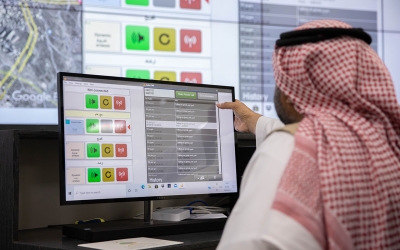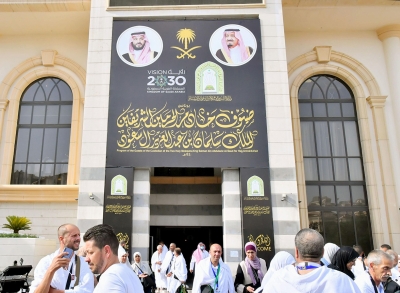

Smart Hajj is streamlining the Hajj rituals process through various smart apps and digital programs to automate and expedite work, ensuring the completion of its requirements in record time. To achieve this, a range of apps dedicated to pilgrims are employed, as well as others for organizers, intermediary apps coordinating various Hajj-related entities, and service apps facilitating pilgrims' access to available services in a convenient and adaptable manner.

Hajj Smart Card
The dedicated Hajj smart card is one of the key components of Smart Hajj. It is linked to the coordinates of the pilgrims' accommodations in the Holy Sites, making it easier for them to reach their residences without any hassle. Additionally, it serves as a digital identity for the pilgrim, containing personal, medical, and residential information, along with his group number, bus details, seat number, residence location, and room and bed numbers. Furthermore, it includes the pilgrim's schedule for gathering points and departure times.
Hajj smart card allows the pilgrims to enter the Holy Sites and quickly access their residences. It also includes Near Field Communication technology (NFC), which allows pilgrims to scan their cards through self-service devices. It also contains a barcode that allows the Hajj workers to know all about the pilgrim's data.
Tawakkalna app
Tawakkalna app, affiliated with the Saudi Data and Artificial Intelligence Authority (SDAIA), is considered one of the standout tools of smart Hajj. It provides Hajj permits and the health status of pilgrims. Additionally, it enables the booking of transportation services between the Holy Sites and the Grand Mosque, facilitates the verification of the rightfulness of the pilgrimage, and ensures the good health condition of the pilgrim.
Smart Hajj Bracelet
The smart Hajj bracelet, called Nusk, is a digital service that relies on data and the Internet of Things to support smart technologies for pilgrimage. It aims to enhance operational and technological systems and provide a qualitative experience for the religious journey of the pilgrim. The bracelet holds all information about the pilgrim and their health status, measures heart rate and blood oxygen levels, enables the request of emergency assistance both in security and medical aspects, and receives informative and directional messages.
Pilgrims' e-track
The e-track system of the Ministry of Hajj and Umrah is one of the prominent smart systems in pilgrimage. It is utilized by all pilgrims, whether arriving from abroad or within the country. This comprehensive system encompasses mandatory contracts related to food, transportation, and accommodation from the pilgrim's arrival until their departure. This ensures transparency, enforces necessary oversight for execution, and guarantees each party's compliance with its assigned responsibilities under the direct supervision of the Ministry of Hajj and Umrah.
The e-track system for local pilgrims encompasses a digital portal housing a range of systems and data. This portal serves as a platform for displaying the service offerings of Hajj institutions and companies, enabling pilgrims to select options that align with their needs. Additionally, it enables pilgrims to engage in electronic contracts based on their preferences. Furthermore, the system is designed to safeguard the rights of pilgrims by establishing a dedicated electronic system for the settlement of contract payments between them and the companies. It also seamlessly transfers Hajj permits to the Ministry of Interior's systems to issue necessary Hajj permits once the contracts are finalized
Smart Hajj apps
The Hajj and Umrah navigator app is considered one of the standout tools of smart Hajj. It contains several digital maps of the Holy Sites, Makkah al-Mukarramah, and al-Madinah al-Munawwarah. These maps include facilities, buildings, and camps in the Holy Sites, as well as roads, streets, neighborhoods, and the locations of public facilities and services. The app relies on the designated national address for numbering buildings, facilities, and camps in the areas that host pilgrims during the Hajj season. Additionally, it incorporates the Nusk app for booking prayers and Umrah rites, and the Adahi Project for performing Hady and Adahi rituals.
Smart Hajj tools include the Turjuman app, which is designed to translate street and square instruction signs into multiple languages offline. Additionally, there is the Maqsad app, which streamlines pilgrims' tasks by specifying their positions inside the Grand Mosque and guiding them through paths to their desired destinations without the need for an internet connection. Furthermore, the Manasikna app is employed to pinpoint popular pilgrim destinations like mosques, shopping centers, and restaurants while also providing the most efficient routes to reach them.
Al-Haramain app is one of the platforms of the General Presidency for the Affairs of the Grand Mosque and the Prophet's Mosque. It provides services and information related to the Grand Mosque for pilgrims and visitors. Additionally, Arafat Sermon app serves as the first assistant for pilgrims to listen to and watch the Arafat Sermon in five languages: English, French, Persian, Malay, and Urdu.
Mutawwif app encompasses a variety of services, including the Arshidni service to assist pilgrims in finding their accommodation, as well as a guide to the Grand Mosque, which contains several illustrated maps of the Grand Mosque and its services. Additionally, it offers the Aftuni service to enable pilgrims to get answers to their questions at all times. The app also contains information about Hajj-related matters or common misconceptions, along with phone numbers that pilgrims may need, prayer times, supplications, and Dhikr.
Another aspect of Smart Hajj is the Tarwiyah app, which is dedicated to serving pilgrims in relation to water services in the vicinity of the Holy Sites. It includes a map to locate restrooms, in addition to a service for reporting water problems and malfunctions, as well as knowing the designated points for Zamzam water distribution. The app is available in seven international languages, making it accessible to a wide range of pilgrims.
Among the services offered by smart Hajj apps are various healthcare services. This includes medical consultations that can be obtained through Seha app, which provides a list of accredited doctors to offer necessary consultations to pilgrims through audio and video calls, with the final evaluation of the case by the doctor. Additionally, there is Asaafni app for reporting emergencies, which allows for precise location identification and supports individuals with special needs.
Smart Hajj initiatives
As part of the initiatives related to Smart Hajj services, there is the Services Supervision initiative, which aims to enhance the level of housing-related services by providing a smart mechanism to organize traffic routes and offer additional spaces for pilgrims. Additionally, the Tafweej Program serves as the control point for managing crowds through a digital system for preparing and monitoring the plans for organizing groups of pilgrims. The Electronic System for the Holy Sites initiative constitutes an electronic regulatory branch aimed at assessing the readiness of the facilities in the Holy Sites. The Hajj without a Bag initiative is one of the prominent facilitations provided to pilgrims through an electronic system that ensures luggage arrival before the travelers and streamlines time and procedures.

Smart crowding management system
The Ministry of Hajj and Umrah implemented the Smart Crowding Management System during the Hajj season of 2022. This system utilizes AI technology to analyze crowd movements at all stations of the Holy Sites train and the main routes leading to the Jamarat Bridge. It is an inaugural integrated system, linked to the supervision room for crowd management to ensure the safety and security of the pilgrims. Moreover, the ministry established an extensive Internet of Things network to cover the Jamarat Bridge and main routes. This system is connected to the Smart Crowding Card carried by the crowd management personnel from the camps to the Jamarat Bridge, enhancing compliance with the crowd management procedures. It is also linked to a data dashboard and business intelligence system to support decision-making on the Smart Crowding Management Platform.
The project aimed to facilitate the movement of crowds at transportation stations, reduce waiting times, and enable control and monitoring of the flow of pilgrims in Mina site across all routes covered by smart cameras. These cameras were used for the first time in the Holy Sites as part of an integrated system to support decision-making.
SDAIA Services
During the Hajj season of 2023, SDAIA introduced a package of smart digital services. It established an advanced integrated technological system, including the creation of Baseer platform to facilitate crowd management in the Grand Mosque and regulate movement according to the capacity at each location. Additionally, it equipped a dedicated section for AI systems at the command and control center for Hajj security in Mina site. Furthermore, various AI and digital services were provided through the Tawakkalna app.
Related quizzes
Related articles


